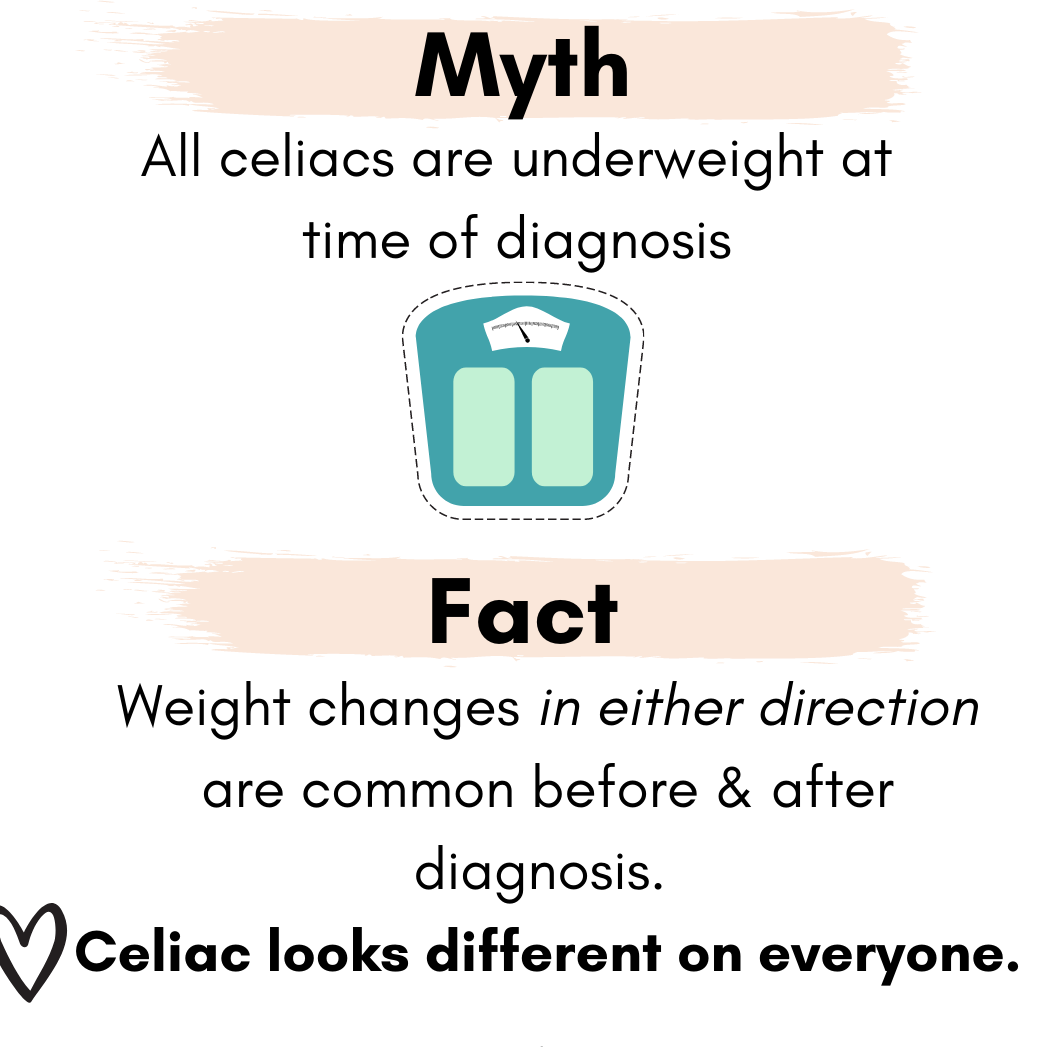
The most infuriating and sad thing a client has ever told me was, “it took me so long to get diagnosed because my doctor said overweight people don’t have celiac.”
At best, this is utterly untrue. At worst, it’s a damaging assumption that dismisses the individual and prolongs or prevents them from receiving care.
Weight fluctuations are very common both leading up to and after celiac diagnosis, but they can go in either direction.
Untreated celiac causes intestinal damage and malabsorption of nutrients, which for many can lead to rapid weight loss (it doesn’t help if chronic diarrhea is on board, either). The problem is that this has painted a singular picture of what an untreated celiac typically looks like, and if you don’t fit into that box, you may have a harder time getting a diagnosis. Even though studies have refuted this, showing that more people are considered overweight than underweight at time of diagnosis,1,2,3 the idea of what a “classic” celiac is persists.
As mentioned, the reason for unintended weight loss is usually malabsorption. But what underlies the cause of unintended weight gain in untreated celiac? Research has shown several mechanisms, most notably hormonal and metabolic dysregulation, as well as inflammation.
Your gastrointestinal tract is heavily involved in hormone regulation affecting other parts of your body. In a disease state, especially one like celiac that is initiated in the gut, hormonal balance can quickly get out-of-whack.
For instance, ghrelin is your “hunger hormone” and stimulates appetite. In untreated celiac, it may be elevated, which means these individuals may feel hungrier.4 Hunger can also be heightened in cases of malabsorption (like celiac) because your body is desperately calling out for the nutrients it’s losing. The good news is that ghrelin usually drops back to “normal” when a person adopts a gluten-free diet. 4
Additionally, there is some evidence showing that insulin and GLP-1, a hormone released by the gut, may be dysregulated in celiacs, contributing to blood sugar instability and suboptimal use of blood sugar.5,6 Metabolism in celiacs also tends to be skewed toward carbohydrate, likely due to fat malabsorption and a higher carb diet.5,6
Another factor that could affect metabolism and weight is the connection between thyroid dysfunction and celiac, particularly Hashimoto’s thyroiditis.7 Hashimoto’s is another autoimmune condition characterized by an underactive thyroid. The thyroid is extremely important in regulating many biological processes, including metabolism, and an underactive thyroid can cause weight gain. If your doctor hasn’t already, make sure to ask them to run a full thyroid panel.
Finally, inflammation and the physical stress that underlies unchecked autoimmune diseases such as celiac can significantly alter hormones and metabolism. For instance, many with chronic disease have high cortisol levels, and cortisol is a hormone which promotes muscle breakdown and storage of fat, especially around the abdominal section.8
Regardless of which way the pendulum may have swung for you leading up to diagnosis, a gluten-free diet, along with the help of a nutritionist to implement it in a personalized and healthy way, typically brings celiacs’ weight back into balance.2,3
That being said, the focus following diagnosis and for quite some time afterwards should just be on rebuilding your health and feeling WELL again. Weight changes are your body’s response to a condition; even if it doesn’t look or feel like it, our bodies are always trying to do their best to cope and protect us. When you turn your care to removing the trigger (gluten) and calming the inflammation, other aspects start to stabilize as well.
I wrote this post to help others understand the effect of celiac on their bodies a little bit better leading up to diagnosis. But most importantly, I wrote this is to acknowledge those who may have had to take a longer road to receive answers about their health based on their body shape, skin color, uncharacteristic symptomology, etc. Here’s to breaking medical assumptions and embracing the fact that celiac looks different on everyone.
References:
- Dickey W, Kearney N. Overweight in celiac disease: prevalence, clinical characteristics, and effect of a gluten-free diet. Am J Gastroenterol. 2006 Oct;101(10):2356-9. doi: 10.1111/j.1572-0241.2006.00750.x. PMID: 17032202.
- Reilly NR, Aguilar K, Hassid BG, Cheng J, Defelice AR, Kazlow P, Bhagat G, Green PH. Celiac disease in normal-weight and overweight children: clinical features and growth outcomes following a gluten-free diet. J Pediatr Gastroenterol Nutr. 2011 Nov;53(5):528-31. doi: 10.1097/MPG.0b013e3182276d5e. PMID: 21670710
- Cheng J, Brar PS, Lee AR, Green PH. Body mass index in celiac disease: beneficial effect of a gluten-free diet. J Clin Gastroenterol. 2010 Apr;44(4):267-71. doi: 10.1097/MCG.0b013e3181b7ed58. PMID: 19779362.
- Malandrino N, Capristo E, Farnetti S, Leggio L, Abenavoli L, Addolorato G, Gasbarrini G. Metabolic and nutritional features in adult celiac patients. Dig Dis. 2008;26(2):128-33. doi: 10.1159/000116770. Epub 2008 Apr 21. PMID: 18431062.
- Vitaglione P, Zingone F, Virgilio N, Ciacci C. Appetite and Gastrointestinal Hormone Response to a Gluten-Free Meal in Patients with Coeliac Disease. Nutrients. 2019;11(1):82. Published 2019 Jan 3. doi:10.3390/nu11010082
- Capristo E, Addolorato G, Mingrone G, De Gaetano A, Greco AV, Tataranni PA, Gasbarrini G. Changes in body composition, substrate oxidation, and resting metabolic rate in adult celiac disease patients after a 1-y gluten-free diet treatment. Am J Clin Nutr. 2000 Jul;72(1):76-81. doi: 10.1093/ajcn/72.1.76. PMID: 10871564.
- Lerner A, Jeremias P, Matthias T. Gut-thyroid axis and celiac disease. Endocr Connect. 2017;6(4):R52-R58. doi:10.1530/EC-17-0021
- Straub RH. Interaction of the endocrine system with inflammation: a function of energy and volume regulation. Arthritis Res Ther. 2014;16(1):203. Published 2014 Feb 13. doi:10.1186/ar4484
